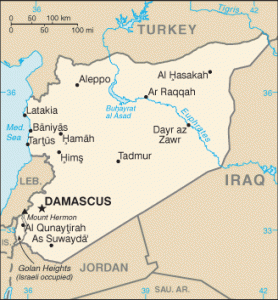A secret State Department cable has concluded that the Syrian military probably used what is technically considered a chemical weapon during an attack in the city of Homs in December, reports Josh Rogin at The Cable.
 A preliminary judgment from US officials just following the December 23 attack in Homs concluded chemical weapons had not been used. But testimony from Syrian oppositions activists and doctors made “a compelling case” otherwise.
A preliminary judgment from US officials just following the December 23 attack in Homs concluded chemical weapons had not been used. But testimony from Syrian oppositions activists and doctors made “a compelling case” otherwise.
An Obama administration official who read the classified cable document, told Rogin, “We can’t definitely say 100 percent, but Syrian contacts made a compelling case that Agent 15 was used in Homs on Dec. 23.”
Doctors in Homs said they could not provide proof because the blood and urine samples they took of the alleged victims – many were exposed to the chemical agent, but only 5 died from the exposure – were now too old.
The only evidence beyond the testimony is YouTube videos which appear to show Syrian rebels choking and regurgitating, which officials say are symptoms of exposure to “Agent 15, known also by its NATO code BZ, which is a CX-level incapacitating agent that is controlled under schedule 2 of the Chemical Weapons Convention, to which Syria is a party,” Rogin reports.
Given the secret classification of the cable, the State Department, ironically, has officially denied any knowledge of the Assad regime’s alleged use of chemical weapons.
State Department Spokesman Patrick Ventrell told Rogin, “As you know, the United States closely monitors Syria’s proliferation-sensitive materials and facilities, and we believe Syria’s chemical weapons stockpile remains secured by the Syrian government. We have been clear that if Assad’s regime makes the tragic mistake of using chemical weapons or failing to secure them, it will be held accountable.”
The Obama administration has stated in recent months that the use of chemical weapons against the Syrian people by the Assad regime is a “red line,” presumably beyond which would prompt US intervention against the regime.
But the truth is, Washington doesn’t perceive any viable plan for military intervention against the Assad regime. Beyond the vastly increased destruction and humanitarian suffering it would cause, the Assad regime appears to be the only thing preventing jihadist terrorists from taking control of the country.
US General Martin Dempsey, Chairman of the Joint Chiefs, said last week that “The act of preventing the use of chemical weapons [in Syria] would be almost unachievable…”
And as Aaron David Miller, a former Middle East advisor to six Secretaries of State, wrote recently, “all of the military options for intervention [in Syria] have been heavily skewed toward risk rather than reward.”
Michael Eisenstadt of the typically hawkish Washington Institute for Near East Policy, wrote recently “While the United States does not have an interest in strengthening Assad, it does have an interest in the regime retaining control over its [chemical weapons] for as long as it is around,” reflecting Washington’s deep desire to keep Syria’s weapons stockpiles out of the hands of the rebels and terrorist groups now fighting the regime.
US military officials have been quick to point out the costs of war in Syria and the White House has consistently said that direct military intervention “would lead to greater chaos, greater carnage.”


